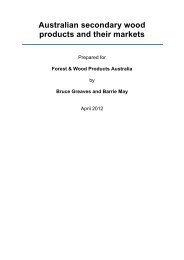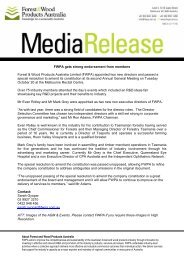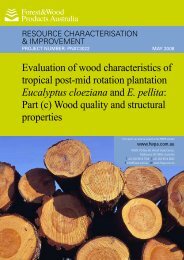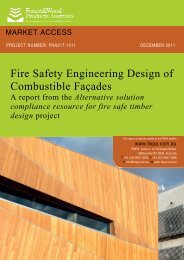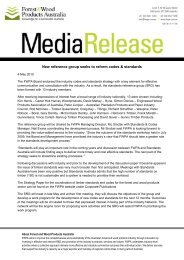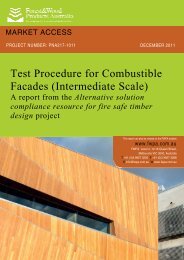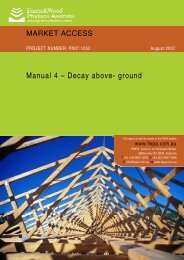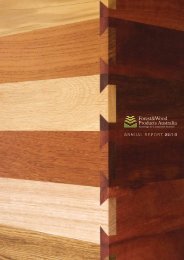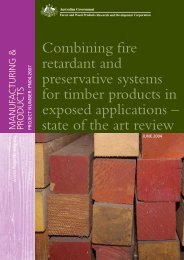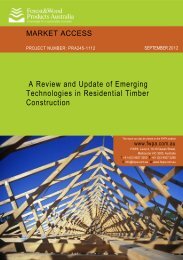PNB290-1112_Uses of plantation Euc eng wood products.pdf
PNB290-1112_Uses of plantation Euc eng wood products.pdf
PNB290-1112_Uses of plantation Euc eng wood products.pdf
Create successful ePaper yourself
Turn your PDF publications into a flip-book with our unique Google optimized e-Paper software.
PROCESSING<br />
PROJECT NUMBER: <strong>PNB290</strong>-<strong>1112</strong> APRIL 2013<br />
Utilisation <strong>of</strong> <strong>plantation</strong> eucalypts in<br />
<strong>eng</strong>ineered <strong>wood</strong> <strong>products</strong><br />
This report can also be viewed on the FWPA website<br />
www.fwpa.com.au<br />
FWPA Level 4, 10-16 Queen Street,<br />
Melbourne VIC 3000, Australia<br />
T +61 (0)3 9927 3200 F +61 (0)3 9927 3288<br />
E info@fwpa.com.au W www.fwpa.com.au<br />
`
Utilisation <strong>of</strong> <strong>plantation</strong> eucalypts in <strong>eng</strong>ineered<br />
<strong>wood</strong> <strong>products</strong><br />
Prepared for<br />
Forest & Wood Products Australia<br />
by<br />
James R B Hague
Publication: Utilisation <strong>of</strong> <strong>plantation</strong> eucalypts in <strong>eng</strong>ineered <strong>wood</strong><br />
<strong>products</strong><br />
Project No: <strong>PNB290</strong>-<strong>1112</strong><br />
This work is supported by funding provided to FWPA by the Australian Government Department <strong>of</strong> Agriculture,<br />
Fisheries and Forestry (DAFF).<br />
© 2013 Forest & Wood Products Australia Limited. All rights reserved.<br />
Whilst all care has been taken to ensure the accuracy <strong>of</strong> the information contained in this publication,<br />
Forest and Wood Products Australia Limited and all persons associated with them (FWPA) as well as<br />
any other contributors make no representations or give any warranty regarding the use, suitability,<br />
validity, accuracy, completeness, currency or reliability <strong>of</strong> the information, including any opinion or<br />
advice, contained in this publication. To the maximum extent permitted by law, FWPA disclaims all<br />
warranties <strong>of</strong> any kind, whether express or implied, including but not limited to any warranty that the<br />
information is up-to-date, complete, true, legally compliant, accurate, non-misleading or suitable.<br />
To the maximum extent permitted by law, FWPA excludes all liability in contract, tort (including<br />
negligence), or otherwise for any injury, loss or damage whatsoever (whether direct, indirect, special<br />
or consequential) arising out <strong>of</strong> or in connection with use or reliance on this publication (and any<br />
information, opinions or advice therein) and whether caused by any errors, defects, omissions or<br />
misrepresentations in this publication. Individual requirements may vary from those discussed in this<br />
publication and you are advised to check with State authorities to ensure building compliance as well<br />
as make your own pr<strong>of</strong>essional assessment <strong>of</strong> the relevant applicable laws and Standards.<br />
The work is copyright and protected under the terms <strong>of</strong> the Copyright Act 1968 (Cwth). All material<br />
may be reproduced in whole or in part, provided that it is not sold or used for commercial benefit and<br />
its source (Forest & Wood Products Australia Limited) is acknowledged and the above disclaimer is<br />
included. Reproduction or copying for other purposes, which is strictly reserved only for the owner or<br />
licensee <strong>of</strong> copyright under the Copyright Act, is prohibited without the prior written consent <strong>of</strong> FWPA<br />
ISBN: 978-1-921763-65-6<br />
Researcher:<br />
James R B Hague<br />
Australian Forest Research Company Pty Ltd<br />
12 Wilton Crescent, Wheelers Hill, VIC 3150, Australia<br />
Forest & Wood Products Australia Limited<br />
Level 4, 10-16 Queen St, Melbourne, Victoria, 3000<br />
T +61 3 9416 7544 F +61 3 9416 6822<br />
E info@fwpa.com.au<br />
W www.fwpa.com.au
Supply Agreement: <strong>PNB290</strong>-<strong>1112</strong><br />
Utilisation <strong>of</strong> <strong>plantation</strong> eucalypts in <strong>eng</strong>ineered<br />
<strong>wood</strong> <strong>products</strong><br />
James R B Hague<br />
August 2012<br />
Ph: +61 408 115 154<br />
Email: enquiries@afrcpl.com.au<br />
Web: www.afrcpl.com.au<br />
12 Wilton Crescent, Wheelers Hill, VIC 3150, Australia<br />
ABN: 88 143 015 785
Table <strong>of</strong> Contents<br />
Table <strong>of</strong> Contents .................................................................................................................................... 1<br />
Executive Summary ................................................................................................................................. 2<br />
Key findings ......................................................................................................................................... 2<br />
Introduction ............................................................................................................................................ 3<br />
Literature Review .................................................................................................................................... 3<br />
Veneer-based EWPs ............................................................................................................................ 4<br />
Glulam ................................................................................................................................................. 7<br />
Strand/flake-based EWPs.................................................................................................................... 8<br />
Fibreboard ........................................................................................................................................... 9<br />
Particleboard ....................................................................................................................................... 9<br />
Current Industry Practice ...................................................................................................................... 11<br />
Veneer-based EWPs .......................................................................................................................... 11<br />
Glulam ............................................................................................................................................... 11<br />
Strand/flake-based EWPs.................................................................................................................. 12<br />
Fibreboard ......................................................................................................................................... 12<br />
Particleboard ..................................................................................................................................... 13<br />
Conclusions ........................................................................................................................................... 13<br />
References ............................................................................................................................................ 14<br />
1
Executive Summary<br />
This document reviews and summarises available information on the utilisation <strong>of</strong> <strong>plantation</strong><br />
eucalypts in <strong>eng</strong>ineered <strong>wood</strong> <strong>products</strong> (EWPs). The primary focus <strong>of</strong> the review was on <strong>Euc</strong>alyptus<br />
globulus (southern blue gum) and E. nitens (shining gum), which comprise the majority <strong>of</strong> the<br />
Australian hard<strong>wood</strong> (eucalypt) <strong>plantation</strong> estate, but other <strong>plantation</strong> eucalypt species were also<br />
considered where information was available.<br />
The EWPs covered in the review included laminated veneer lumber (LVL) and ply<strong>wood</strong>, glulam,<br />
flake/strand-based <strong>products</strong>, fibreboard and particleboard.<br />
Key findings<br />
The available information on the suitability <strong>of</strong> Australian-grown <strong>plantation</strong> eucalypts for<br />
EWPs is scarce. Furthermore, that which does exist is typically based on limited replication<br />
within given studies.<br />
It is evident that significantly more research has been conducted overseas, particularly in<br />
South America and South-western Europe. Furthermore, it is apparent that <strong>wood</strong> processing<br />
industries in these regions have been utilising <strong>plantation</strong> eucalypt resources for some time<br />
for a variety <strong>of</strong> EWPs.<br />
Fast-grown, lower density eucalypts generally present no major difficulties with respect to<br />
adhesion; any <strong>of</strong> the adhesive systems conventionally used by the EWP industry could in all<br />
likelihood be used by Australian EWP manufacturers to produce fit-for-purpose <strong>products</strong><br />
from <strong>plantation</strong> eucalypt resources with air-dry densities less than 650 kg/m 3 .<br />
Based on available published research data and current practices in the global EWP industry,<br />
it is believed that much <strong>of</strong> the current Australian <strong>plantation</strong> eucalypt resource (i.e. that<br />
originally planted for <strong>wood</strong> chip and pulp), and in particular E. globulus, E. nitens and E.<br />
grandis, would be suitable for use as a feedstock for LVL, selected strand/flake-based EWPs<br />
and medium density fibreboard.<br />
Further research efforts should primarily be directed towards tree breeding and improved<br />
silvicultural practices e.g. breeding for optimum density (500 to 550 kg/m 3 ) and pruning to<br />
reduce the incidence <strong>of</strong> defects. This would potentially open up opportunities for utilisation<br />
<strong>of</strong> the <strong>plantation</strong> eucalypt resource for ply<strong>wood</strong> and glulam, as well as further increasing<br />
opportunities for utilisation in other EWP markets.<br />
2
Introduction<br />
The purpose <strong>of</strong> this document is to review and summarise available information on the utilisation <strong>of</strong><br />
<strong>plantation</strong> eucalypts for <strong>eng</strong>ineered <strong>wood</strong> <strong>products</strong> (EWPs), with emphasis on gluing systems, the<br />
properties and performance <strong>of</strong> EWPs and any inherent limitations on the uses <strong>of</strong> particular eucalypt<br />
species. An assessment <strong>of</strong> current global industry practices with respect to the utilisation <strong>of</strong><br />
<strong>plantation</strong> eucalypts is also included.<br />
In undertaking the review, the primary eucalypt species <strong>of</strong> interest were <strong>Euc</strong>alyptus globulus<br />
(southern blue gum) and E. nitens (shining gum), since these together comprise around 75 percent<br />
<strong>of</strong> the hard<strong>wood</strong> <strong>plantation</strong> (eucalypt) estate in Australia. However, other species which comprise<br />
the majority <strong>of</strong> the remaining hard<strong>wood</strong> <strong>plantation</strong> (eucalypt) estate were also considered where<br />
information was available; these included E. pilularis (blackbutt), E. grandis (flooded gum), E.<br />
regnans (mountain ash), E. cloeziana (Gympie messmate), E. dunnii (Dunns white gum) and<br />
Corymbia spp. (spotted gums).<br />
Literature Review<br />
EWPs comprise a wide range <strong>of</strong> product types. Those considered in this review included:<br />
Veneer-based. Primary examples <strong>of</strong> this EWP type include ply<strong>wood</strong> and laminated veneer<br />
lumber (LVL). Veneers are produced by rotary peeling <strong>of</strong> logs on lathes. After drying the<br />
veneers in ovens, adhesive is applied to the veneer surfaces, and they are laid together and<br />
hot-pressed to form the finished panel. In ply<strong>wood</strong> the grain angle <strong>of</strong> adjacent veneers is at<br />
right angles; in LVL the grain angle <strong>of</strong> all veneers is parallel.<br />
Glued laminated lumber (glulam). Glulam is produced by clamping and gluing together<br />
l<strong>eng</strong>ths <strong>of</strong> seasoned, dressed lumber. The adhesives used typically cure at ambient<br />
temperature, though in some operations radio frequency heating is utilised to increase the<br />
rate <strong>of</strong> adhesive cure.<br />
Strand/flake-based. Examples include oriented strand board (OSB), oriented strand lumber<br />
(OSL), parallel strand lumber (PSL) and <strong>eng</strong>ineered strand lumber (ESL). These <strong>products</strong> are<br />
comprised <strong>of</strong> thin strands or flakes, bonded together by adhesive. In OSB the strands in the<br />
core layers are oriented at right angles to those in the surface layers. In lumber-based<br />
<strong>products</strong> the strands are parallel.<br />
Fibreboard. Examples include medium density fibreboard (MDF), high density fibreboard<br />
(HDF) and hardboard (Masonite). MDF and HDF are made from <strong>wood</strong> fibre produced by<br />
pressurised refining <strong>of</strong> <strong>wood</strong> chips. Adhesive may be applied either before or after drying <strong>of</strong><br />
the fibre. Hardboard is produced from <strong>wood</strong> fibre that may be produced either by<br />
pressurised refining or steam explosion <strong>of</strong> <strong>wood</strong> chips. A mixture <strong>of</strong> fibre and water is<br />
applied to a moving wire to form a mattress, which is then hot pressed to form the final<br />
panel. No adhesive is used in the process.<br />
Particleboard. Particles are generated from <strong>wood</strong> chips and sawdust in ring flakers and<br />
hammermills. After drying and blending with adhesive the particles are formed into<br />
mattresses prior to hot pressing. Typically the coarser particles are in the core <strong>of</strong> the panel<br />
and the finer particles on the surfaces.<br />
3
Veneer-based EWPs<br />
Until relatively recently little or no work on the suitability <strong>of</strong> Australian-grown <strong>plantation</strong> eucalypts<br />
for veneer-based <strong>products</strong> had been published. The knowledge base has, however, been significantly<br />
improved with the publication <strong>of</strong> two Forest and Wood Products Australia (FWPA) reports in the last<br />
four years (Hopewell, Atyeo & McGavin, 2008; Farrell et al, 2011).<br />
The studies conducted by Farrell et al (2011) were focused on assessing the suitability <strong>of</strong> the two<br />
main <strong>plantation</strong> species <strong>of</strong> interest in this work, E. nitens and E. globulus, for their potential to<br />
produce veneer and ply<strong>wood</strong>. The material studied was grown in Tasmania, and was comprised <strong>of</strong><br />
two ages <strong>of</strong> E. nitens (16 and 26 years old (YO)) and 33 YO E. globulus. The key findings from the<br />
work were as follows:<br />
The stiffness <strong>of</strong> the E. globulus and 26 YO E. nitens veneer was relatively high, indicating they<br />
had the potential to produce structural peeled <strong>products</strong> (ply<strong>wood</strong> and LVL). The lower<br />
density <strong>of</strong> the E. nitens 26 YO resource could be advantageous in terms <strong>of</strong> stiffness per unit<br />
mass.<br />
The visual grade recovery <strong>of</strong> veneers was no better than Grade D 1 for all resources, though<br />
the E. globulus veneers were typically <strong>of</strong> better quality; around 50 percent <strong>of</strong> the E. nitens<br />
veneer failed even to make visual Grade D. A predominant cause <strong>of</strong> the low grade <strong>of</strong> the<br />
veneers was the high incidence <strong>of</strong> knots, including dead knots.<br />
All ply<strong>wood</strong> made from the E. globulus and 26 YO E. nitens veneer using phenolic adhesive<br />
achieved Type A bond quality. However, results for ply<strong>wood</strong> made from the 16 YO E. nitens<br />
veneer were variable. One batch achieved a 73 percent pass result, whilst a second only<br />
achieved a 13 percent pass result; the poor performance <strong>of</strong> the latter was attributed to high<br />
veneer moisture content during processing.<br />
Based on estimated characteristic modulus <strong>of</strong> elasticity (MoE) 2 values, ply<strong>wood</strong> panels with<br />
F-ratings 3 <strong>of</strong> F34, F27 and F11 (parallel to the face grain) were produced from E. globulus, E.<br />
nitens 26 YO and E. nitens 16 YO respectively; the F-rating dropped to F17 for E. nitens 26 YO<br />
when the estimated characteristic modulus <strong>of</strong> rupture (MoR) 4 values were taken into<br />
account. However, when estimated characteristic shear str<strong>eng</strong>th values were taken into<br />
account, ply<strong>wood</strong> panels with F-ratings <strong>of</strong> F8, F7 and
ply<strong>wood</strong>. The E. cloeziana material was 19 years old, whilst the E. pellita was 15 years old. The key<br />
findings from the work were as follows:<br />
E. pellita billets were prone to end splitting and also contained pockets <strong>of</strong> white rot; these<br />
factors significantly reduced the veneer recovery rate. In contrast the veneer recovery rate<br />
<strong>of</strong> the E. cloeziana was twice that <strong>of</strong> the E. pellita, comparing favourably with that typically<br />
achieved in industry for commercial regrowth species such as E. pilularis and mature-forest<br />
Corymbia spp. The E. cloeziana veneer was generally <strong>of</strong> a higher quality.<br />
The E. pellita ply<strong>wood</strong> panels achieved stress grades in the range F11 to F14, which is typical<br />
for structural s<strong>of</strong>t<strong>wood</strong> ply<strong>wood</strong>. In contrast, the E. cloeziana ply<strong>wood</strong> panels achieved<br />
stress grades in the range F22 to F27, which is equivalent to those typically found at the<br />
higher end for domestic hard<strong>wood</strong> ply<strong>wood</strong> from native forest.<br />
However, E. pellita performed better in the glue bond quality tests. For Type A 5 bonds,<br />
commercially produced panels achieved a 100 percent pass rate, whilst laboratory made<br />
panels achieved a 90 percent pass rate; for E. cloeziana the respective pass rates were 80<br />
percent and 42 percent. It was postulated that the poorer results achieved for E. cloeziana<br />
might be attributable to its higher density.<br />
Both species failed to produce panels with satisfactory Type B 6 bonds. This was difficult to<br />
explain, given the results obtained for Type A bond testing.<br />
The low grade recovery observed by Farrell et al (2011) in veneer derived from unpruned E. nitens is<br />
in agreement with observations made by researchers who investigated the suitability <strong>of</strong> 15 YO<br />
unpruned E. nitens grown in New Zealand for making LVL (Gaunt, Penellum & McKenzie, 2003;<br />
McKenzie, Gea, & Gaunt, 2006). In this work, 93 percent <strong>of</strong> the veneers produced failed to achieve<br />
the minimum ply<strong>wood</strong> grade because <strong>of</strong> knots. Veneer peeled from unpruned logs was segregated<br />
into three stiffness classes using an acoustic test, and LVL was manufactured with phenolic adhesive<br />
from sheets <strong>of</strong> each stiffness class. Subsequent str<strong>eng</strong>th tests showed that the sheets were<br />
successfully segregated by the acoustic stiffness test, and that the E. nitens LVL had str<strong>eng</strong>th and<br />
stiffness properties which were higher than those <strong>of</strong> LVL made from New Zealand-grown Pinus<br />
radiata veneer.<br />
Lisperguer and Rozas (2005) also investigated the suitability <strong>of</strong> Chilean-grown 11 YO juvenile E.<br />
nitens <strong>wood</strong> for manufacturing exterior grade ply<strong>wood</strong> panels. Laboratory panels made from E.<br />
nitens veneers met the British Standard Institution 7 requirements for exterior use.<br />
A number <strong>of</strong> researchers from South America and South-western Europe (Iberia) have investigated<br />
the suitability <strong>of</strong> E. globulus and E. grandis for veneer-based <strong>products</strong>. Much <strong>of</strong> the research appears<br />
to have been focused on using modified phenolic adhesives, with the aim <strong>of</strong> reducing both cost and<br />
environmental footprint. Vázquez and various co-workers have conducted a number <strong>of</strong> such studies<br />
(Vázquez et al 1992; Vázquez et al 1997; Vázquez, González & Antorrena 2000; Vázquez et al 2003).<br />
5 Permanent structural bond that will not deteriorate under wet conditions, heat or cold.<br />
6 Structural bond that will eventually deteriorate under wet conditions, heat or cold.<br />
7 The specifications in national standards are broadly similar around the globe. As such, where it is<br />
demonstrated that <strong>products</strong> meet the specifications in a given national standard, it is highly likely that they will<br />
also meet the specifications given in Australian standards.<br />
5
Vázquez et al (1992) investigated resins made from resoles and Pinus pinaster (maritime pine) bark<br />
tannins by copolymerization at room temperature. The moisture content <strong>of</strong> the tannins was reduced<br />
to below 60 percent to increase their stability. Various formulations were tested, with 50 percent <strong>of</strong><br />
the phenols substituted by the tannins. The resins were used to manufacture 5-ply E. globulus panels<br />
which all met British Standard 1455: 1963 quality requirements.<br />
Vázquez et al (1997) investigated the use <strong>of</strong> lignin-phenol-formaldehyde resins as binders for E.<br />
globulus and pine ply<strong>wood</strong>. Lignin obtained from eucalyptus <strong>wood</strong> by acetic acid pulping was<br />
methylolated or phenolated and used to prepare lignin-phenol-formaldehyde resins. Pine and<br />
eucalyptus ply<strong>wood</strong> panels manufactured using the resins complied with European Standard EN 314-<br />
1:1993, and gave knife test results similar to those <strong>of</strong> panels manufactured with a commercial<br />
phenol-formaldehyde resin.<br />
Vázquez, González, & Antorrena (2000) re-examined the use <strong>of</strong> tannins extracted from Pinus<br />
pinaster bark as partial replacements for phenol in adhesives for exterior-grade E. globulus ply<strong>wood</strong>.<br />
They stated that such adhesives present advantages compared with commercial phenolformaldehyde<br />
(PF) adhesives, since they are more tolerant <strong>of</strong> higher veneer moisture contents, allow<br />
the use <strong>of</strong> higher pressing temperatures, and improve adhesive spreading and wettability. Similar<br />
results were obtained by Vázquez et al (2003) when studying the influence <strong>of</strong> rotary peeling on the<br />
behaviour <strong>of</strong> tight and loose sides <strong>of</strong> E. globulus veneers.<br />
Stefani et al (2008) also investigated the use <strong>of</strong> PF resoles containing Acacia mearnsii (black wattle)<br />
tannin extract to produce ply<strong>wood</strong> panels from E. globulus veneers. The effect <strong>of</strong> processing<br />
conditions and tannin content on the gelation time <strong>of</strong> the adhesive in the glue line was evaluated by<br />
dynamic-mechanical analysis. The results were related to shear str<strong>eng</strong>th and <strong>wood</strong> failure <strong>of</strong> the<br />
glue line in the panels. It was shown that phenol could be partially substituted with tannin without<br />
compromising panel properties.<br />
Dias & Lahr (2004) investigated the suitability <strong>of</strong> a castor oil-based polyurethane adhesive,<br />
developed at the São Carlos Institute <strong>of</strong> Chemistry, University <strong>of</strong> São Paulo, Brazil for bonding E.<br />
grandis veneers. The properties <strong>of</strong> the resulting ply<strong>wood</strong> were determined in accordance with<br />
Brazilian standards; the test results exceeded minimum requirements and were better than those<br />
typically reported in the literature.<br />
Saviana, Sosa Zitto & Piter (2009) investigated the properties <strong>of</strong> LVL manufactured from Argentinean<br />
E. grandis. The characteristic str<strong>eng</strong>th value was 74 percent and 118 percent higher, respectively,<br />
than those adopted by Argentinean standards for the best str<strong>eng</strong>th class <strong>of</strong> sawn timber and glulam<br />
<strong>of</strong> the same species. It was similar to that reported for LVL <strong>of</strong> Picea abies (Norway spruce), but lower<br />
than that published for LVL made from Uruguayan-grown E. grandis. However, the product had a<br />
higher stiffness than that published for Norway spruce and Uruguayan-grown E. grandis LVL.<br />
It is worth noting that over 15 years ago CSIRO did investigate the potential for using eucalypts for<br />
the manufacture <strong>of</strong> LVL (McCombe et al 1997). However, the work was conducted on mixed species<br />
(E. regnans, E. delegatensis (alpine ash), E. sieberi (silvertop ash), E. globoidea (white stringybark), E.<br />
fastigata (cuttail), E. obliqua (messmate) and E. cypellocarpa (mountain grey gum)) residue logs from<br />
sawlog harvesting operations in natural forests in the Central Highlands and East Gippsland regions<br />
<strong>of</strong> Victoria. Whilst the LVL produced from the studies had high F-ratings (in the range F22 to F27),<br />
6
there were significant issues with the recovery rates from the resource. Overall recoveries from log<br />
to finished LVL product were in the range 33 to 35 percent; the authors noted that recovery rates <strong>of</strong><br />
50 to 55 percent would typically be expected from peeler grade Pinus species logs.<br />
E. pilularis (from natural forest) was for many years viewed as a potential resource for use in EWPs;<br />
one particular identified application was as ply<strong>wood</strong> flooring in cargo containers, where there is a<br />
requirement for high str<strong>eng</strong>th and stiffness. However, the species has long been known to be<br />
difficult to glue with PF adhesives, in part because <strong>of</strong> its high density, but primarily due to the<br />
composition and quantity <strong>of</strong> extractives present in the <strong>wood</strong> (Yazaki, Collins & Iwashina 1993; Yazaki,<br />
Collins & McCombe 1994). CSIRO conducted a number <strong>of</strong> investigations (unpublished) in the period<br />
1995 to 2005, aimed at trying to identify ways <strong>of</strong> achieving acceptable PF-bond quality in E. pilularis<br />
ply<strong>wood</strong> and LVL. Approaches examined included incorporation <strong>of</strong> resorcinol or tannins in the PF<br />
adhesive, using a variety <strong>of</strong> additives and using the PF adhesive in emulsified form. Whilst some<br />
encouraging results were obtained, the adhesives industry showed little interest in the technology;<br />
the high density <strong>of</strong> the timber, and likely consequent small market demand for any resulting EWPs,<br />
was cited as the primary issue.<br />
Glulam<br />
No references to published work in Australia on the use <strong>of</strong> <strong>plantation</strong> eucalypts for glulam are<br />
evident in the literature. However, a number <strong>of</strong> South American researchers have published papers<br />
in recent years. Azambuja & Dias (2006) investigated the use <strong>of</strong> castor oil-based polyurethane<br />
adhesives for the production <strong>of</strong> glulam made from Brazilian-grown E. grandis and Pinus caribea<br />
(Caribbean pine). The performance <strong>of</strong> the adhesive was compared with that <strong>of</strong> a standard industry<br />
PF adhesive. The E. grandis glulam performed well with both adhesive types.<br />
Lisperguer & Rozas (2005) evaluated bond quality in the solid <strong>wood</strong> <strong>of</strong> 11 YO Chilean-grown E.<br />
nitens. Edge-glued panels were manufactured and bonded with a non-structural PVA adhesive. The<br />
mechanical properties <strong>of</strong> the panels were determined and compared with those <strong>of</strong> 25 YO Pinus<br />
radiata panels. Shear str<strong>eng</strong>th values in E. nitens panels were found to be 35 percent higher than in<br />
P. radiata panels.<br />
Neto (2010) investigated the properties <strong>of</strong> Brazilian-grown E. grandis and E. urograndis (E. grandis x<br />
E. urophylla (Timor white gum)) glulam bonded with a two component polyurethane adhesive. He<br />
also investigated the influence <strong>of</strong> preservative treatments (copper chrome arsenic (CCA) and copper<br />
chrome boron (CCB)) on bond quality. The mode <strong>of</strong> bond failure for both treated and untreated<br />
beams was variable, with a mixture <strong>of</strong> both <strong>wood</strong> and glueline failure (this is quite typical for<br />
polyurethane adhesives, and is one <strong>of</strong> the key reasons for objections to their adoption as structural<br />
adhesives alongside PF, phenol resorcinol formaldehyde (PRF) and resorcinol formaldehyde (RF)<br />
adhesives). Nevertheless, Neto (2010) concluded that the preservative treatments had no significant<br />
impact on bond str<strong>eng</strong>ths, and that the latter met minimum str<strong>eng</strong>th requirements.<br />
Santos et al (2010) studied the deflection properties <strong>of</strong> PF-bonded E. urograndis glulam cross-arm<br />
beams for application in the Brazilian electricity industry. The properties <strong>of</strong> the three member beams<br />
were compared with those made with Pinus taeda (loblolly pine) lumber. When subjected to<br />
standard loads, the eucalypt beams easily met the requirements <strong>of</strong> the Brazilian standard in terms <strong>of</strong><br />
maximum allowable deflection, and also outperformed the pine beams.<br />
7
At the last two Forest Products Society (FPS) International Conventions (2011 and 2012) in the USA<br />
Uruguayan researchers have presented data on the properties <strong>of</strong> glulam made from fast grown<br />
Uruguayan <strong>plantation</strong> eucalypts. However, no further details are available on the content <strong>of</strong> their<br />
presentations; the FPS does not publish proceedings from its conventions, and the authors <strong>of</strong> the<br />
presentations failed to respond to requests for further information.<br />
Strand/flake-based EWPs<br />
Research in Australia on strand/flake-based EWPs has primarily been conducted by CSIRO. The latter<br />
investigated the suitability <strong>of</strong> <strong>plantation</strong> E. globulus and E. nitens for OSB over a decade ago<br />
(Freischmidt et al 2001; Freischmidt 2001; Freischmidt, Hague & Warden 2001). The test material<br />
was 17 YO from the ACT region. OSB panels were fabricated with a commercially available PF resin<br />
and tested for flexural properties, internal bond str<strong>eng</strong>th and thickness swelling. Str<strong>eng</strong>th properties<br />
were satisfactory when compared to the Canadian Standard, but dimensional stability, particularly<br />
when exposed to cyclic environmental conditions, was relatively poor. This was likely linked in part<br />
to the relatively high density <strong>of</strong> the two materials, but also to the need to optimise adhesive and<br />
processing parameters.<br />
More recently an Australian company, Lignor, has developed technology to utilise <strong>plantation</strong> E.<br />
globulus in an <strong>eng</strong>ineered strand lumber (ESL) product. It is believed that much <strong>of</strong> the research was<br />
conducted in Europe by potential equipment suppliers for a full scale production plant. The adhesive<br />
used was a polyurethane (polymeric methylene diphenyl diisocyanate (pMDI)); it is believed that this<br />
was chosen primarily to avoid the use <strong>of</strong> formaldehyde-based adhesives, rather than <strong>of</strong> necessity i.e.<br />
there were no inherent adhesion issues with the <strong>wood</strong> substrate.<br />
According to Freischmidt & Blakemore (2009) a number <strong>of</strong> trials were undertaken with young aged<br />
eucalypt ‘thinnings’ during the development <strong>of</strong> the CSIRO invented ‘Scrimber’ product. Plantation<br />
thinnings <strong>of</strong> E. globulus and E. pilularis were used in early trials (1980 and 1981) using a variety <strong>of</strong><br />
different resins (e.g. urea formaldehyde (UF), tannin formaldehyde and polyurethanes). The <strong>wood</strong><br />
was reported to have ‘scrimmed’ well and was successfully bonded, but no mechanical performance<br />
data were presented. A 1990 trial investigated E. sieberi thinnings as a resource; the resultant beams<br />
were reported to have excellent stiffness, although there were issues with bond starvation during<br />
resin application. Another series <strong>of</strong> trials was carried out in the mid 1990s by the US-based Georgia<br />
Pacific at the now closed Mount Gambier production plant, in which young <strong>plantation</strong> E. grandis was<br />
processed. No data are available from the trial, but it is known that Scrimber beams were<br />
successfully produced.<br />
Vintorg is a composite material that was developed in the Cooperative Research Centre (CRC) for<br />
Wood Innovations in the last decade. It is produced by impregnating Torvin (microwave treated<br />
timber) with thermosetting adhesives (MUF, pMDI etc.) and hot pressing. The resultant product<br />
shows modest improvements in stiffness and creep resistance compared with the original substrate.<br />
An undated CRC fact sheet sighted by the author refers to research conducted on ‘s<strong>of</strong>t<strong>wood</strong>s as well<br />
as Australia’s unique hard<strong>wood</strong> timbers’. It also states that the ‘research focus emphasises<br />
utilisation <strong>of</strong> young, fast growing <strong>plantation</strong> timbers’. However, no other supporting information<br />
could be found in the literature.<br />
8
A number <strong>of</strong> studies have been undertaken overseas to investigate the suitability <strong>of</strong> <strong>plantation</strong><br />
eucalypts for OSB. The work has primarily been undertaken by South American researchers.<br />
Gouveia, Santana & Souza (2000) investigated E. grandis and E. urophylla as feedstocks in nonoriented<br />
and oriented panels; they concluded that E. grandis was the superior feedstock. Gouveia,<br />
Vital & Santana (2003) also investigated blends <strong>of</strong> E. grandis and Pinus elliottii (slash pine) feedstocks<br />
for OSB; optimum results were obtained with blends comprising between 50 percent and 75 percent<br />
E. grandis. Iwakiri, Mendes & Saldanha (2003) investigated E. grandis as a feedstock for OSB, with<br />
varying resin and wax levels, and face to core weight proportions. Higher resin loadings (from 3 to 6<br />
percent) improved mechanical and physical properties and a 60 percent by weight core layer<br />
improved panel flexural properties. Iwakiri et al (2004) investigated a broader range <strong>of</strong> potential<br />
feedstocks for OSB, including: E. grandis, E. dunnii, E. tereticornis (forest red gum), E. saligna (Sydney<br />
blue gum), C. citriodora and C. maculata. Test panels were manufactured to a target density <strong>of</strong> 700<br />
kg/m 3 using 6 percent PF adhesive. E. grandis and E. saligna appeared to be the most promising<br />
feedstocks, with the former giving similar or higher average panel properties in comparison with<br />
Pinus taeda, the main species used for OSB production in Brazil.<br />
Fibreboard<br />
Available information on Australian studies looking at <strong>plantation</strong> eucalypts for fibreboard is scarce.<br />
Freischmidt & Blakemore (2009) cite a study conducted by CSIRO in 1998 (Coutts et al) in which both<br />
mature and younger age E. obliqua, E. sieberi and E. globoidea were investigated as feedstocks for<br />
MDF. UF, PF and polyurethane adhesives were trialled, with refined and dried furnish being dry<br />
blended before hot pressing into panels. The results were mixed, with high adhesive loadings and<br />
high panel densities required in order to achieve acceptable properties. Intriguingly, Freischmidt &<br />
Blakemore (2009) state that the study also included ‘some preliminary trials on <strong>plantation</strong> grown E.<br />
grandis and E. globulus to determine processing conditions for fibre production’. However, it<br />
appears that the resulting furnish was not evaluated for its suitability for panel manufacture.<br />
Freischmidt & Blakemore (2009) also cite a second study (Olsen et al 2004) in which CSIRO<br />
investigated two eucalypt species, E. loxophleba (York gum) and E. rudis (WA flooded gum) as<br />
feedstocks for MDF. UF-bonded panels had promising properties at more realistic panel densities<br />
than those in the above study. This was likely in part attributable to the improved pilot scale<br />
production facilities available to the researchers.<br />
Published overseas research on the use <strong>of</strong> <strong>plantation</strong> eucalypts for fibreboard is also limited. Krzysik<br />
et al (2001) conducted research to determine the suitability <strong>of</strong> <strong>plantation</strong> grown E. saligna from<br />
Brazil as a feedstock for MDF. Test panels <strong>of</strong> varying thickness (6, 13, and 19 mm) were made with<br />
10 percent UF resin and 1.5 percent wax. Mechanical, water resistance, and dimensional stability<br />
properties were tested according to ASTM (American Society for Testing and Materials) standards.<br />
The results showed that nearly all the mechanical properties <strong>of</strong> the panels at all thickness levels<br />
were above the minimum specified requirements for MDF in the ANSI (American National Standards<br />
Institute) and European MDF standards.<br />
Particleboard<br />
There is no published work on the use <strong>of</strong> Australian-grown <strong>plantation</strong> eucalypts for particleboard<br />
production. Published data from overseas are again dominated by South American researchers.<br />
9
Haselein et al. (1989) investigated combining Brazilian-grown E. grandis with a Cecropia species; a<br />
50:50 (by weight) mixture produced the best results. The same authors (Haselein et al 2003) also<br />
investigated blends <strong>of</strong> E. grandis with A. mearnsii and P. elliottii and found similar results.<br />
Niekerk & Pizzi (1994) presented data from studies conducted at a South African particleboard plant<br />
which utilised E. grandis as the feedstock and a tannin-based adhesive to produce a moisture<br />
resistant product. They highlighted two key problems that the plant had had to overcome in order to<br />
be viable: a) the low pH <strong>of</strong> the eucalypt furnish, particularly in the high steam environment<br />
developed in the mattress during hot pressing, which inhibited cure <strong>of</strong> the tannin adhesive, and b)<br />
the resistance <strong>of</strong> the eucalypt <strong>wood</strong> particles to crushing (and irreversible fracture) during the hot<br />
pressing process, which in turn resulted in poor dimensional stability <strong>of</strong> the finished panel. The<br />
adhesive curing problem was solved by raising the pH <strong>of</strong> the tannin adhesive prior to blending with<br />
the <strong>wood</strong> particles. The dimensional stability issue was addressed by using a smaller mean particle<br />
size in the <strong>wood</strong> furnish than is typically used with lower density feed-stocks.<br />
More recently Cabral et al (2007) investigated the properties <strong>of</strong> particleboards made with particles<br />
generated from planer shavings and flakes <strong>of</strong> Brazilian-grown E. grandis, E. urophylla and E.<br />
cloeziana; P. elliottii particles were mixed with eucalypt particles, where necessary, in order to<br />
achieve target board densities <strong>of</strong> 700 kg/m 3 . Samples <strong>of</strong> each <strong>of</strong> the eucalypt species were obtained<br />
from two different sites, with the E. grandis typically having the lowest density (approx. 550 kg/m 3 )<br />
and the E. cloeziana the highest (approx. 700 kg/m 3 ); the density <strong>of</strong> the P. elliottii was 450 kg/m 3 .<br />
The prepared particles were mixed with UF adhesive prior to hot pressing into boards. Generally<br />
boards made with the highest proportions <strong>of</strong> eucalypt particles had the highest water adsorption<br />
and thickness swelling. Boards made with particles generated from flakes tended to exhibit the<br />
highest internal bond str<strong>eng</strong>th, modulus <strong>of</strong> rupture and modulus <strong>of</strong> elasticity.<br />
Pan et al (2007) investigated the properties <strong>of</strong> thin particleboard made from 8 YO Californian-grown<br />
E. cinerea (Mealy stringybark), a eucalypt species with potential to be used as a biomass crop in<br />
salinity prone agricultural regions. The properties <strong>of</strong> boards were compared with those made from E.<br />
camaldulensis (river red gum) <strong>of</strong> a similar age, grown under non-saline conditions. The densities <strong>of</strong><br />
the two substrates were 770 and 760 kg/m 3 respectively. A range <strong>of</strong> variables were investigated,<br />
including particle size, bark content, resin type and addition level (pMDI (4 percent) and UF (7, 10, 13<br />
& 16 percent)) and hot water pre-treatment. The results were largely as might be expected:<br />
increasing the UF adhesive content improved board properties; boards bonded with 4 percent pMDI<br />
generally had better properties than those bonded with 7 percent UF; increasing the bark content <strong>of</strong><br />
the <strong>wood</strong> furnish reduced board properties; pre-treating particles in hot water significantly<br />
improved board properties. Boards made with E. cinerea particles had markedly better properties<br />
than those made with E. camaldulensis. Pan et al (2007) postulated that the improvements in board<br />
properties from hot water pre-treatment could have been due to changes in the chemical<br />
composition <strong>of</strong> particles (in particular a reduction in the level <strong>of</strong> alkaline extractives which are more<br />
prevalent in timber grown in saline conditions) and/or changes to the physical characteristics <strong>of</strong> the<br />
particles at the cellular level.<br />
Colak et al (2007) studied the influence <strong>of</strong> log pre-steaming on the properties <strong>of</strong> particleboard made<br />
with 12 YO Turkish-grown E. camaldulensis bonded with UF and MUF adhesives. The results were<br />
10
not clear cut, but there was some suggestion that pre-steaming improved the dimensional stability<br />
<strong>of</strong> the finished panel, but reduced the internal bond str<strong>eng</strong>th.<br />
Current Industry Practice<br />
Veneer-based EWPs<br />
No <strong>wood</strong> processing companies in Australia are currently utilising any significant quantities <strong>of</strong><br />
<strong>plantation</strong>-grown eucalypts to produce either veneer or veneer-based EWPs. According to S Dorries<br />
(2012, pers. comm., 17 Aug.), General Manager <strong>of</strong> Engineered Wood Products Association <strong>of</strong><br />
Australasia (EWPAA), Ta Ann Tasmania may process small quantities <strong>of</strong> <strong>plantation</strong> eucalypt on<br />
occasion, but it predominantly peels a mixture <strong>of</strong> regrowth eucalypt species, primarily E. obliqua, E.<br />
regnans and E. delegatensis and exports the resulting veneer, mainly to Malaysia, for the<br />
manufacture <strong>of</strong> LVL, ply<strong>wood</strong> and flooring (Freischmidt & Blakemore, 2009). Forestry Tasmania has<br />
recently launched and showcased a range <strong>of</strong> LVL-based <strong>products</strong> (framing, flooring, furniture etc.)<br />
made using veneer generated from small diameter and low grade logs <strong>of</strong> the same species as those<br />
processed by Ta Ann. Big River Timbers (NSW) also produces hard<strong>wood</strong> ply<strong>wood</strong> from E. pilularis, E.<br />
grandis, Corymbia spp and a range <strong>of</strong> other species sourced from natural forest.<br />
The situation in Australia contrasts strongly with that in South America and Iberia, where significant<br />
quantities <strong>of</strong> veneer-based EWPs are being produced from <strong>plantation</strong> eucalypts. Species being<br />
processed include E. grandis, E. globulus and E. urograndis. Weyerhaeuser in the USA has made<br />
significant investments in South America, in particular Uruguay, where its eucalypt ply<strong>wood</strong><br />
(Lumin) is produced; the latter is rapidly gaining acceptance as a product <strong>of</strong> choice in the USA for a<br />
variety <strong>of</strong> applications, including construction, furniture, cabinetry, flooring, doors, transportation<br />
and toys. However, some <strong>of</strong> the ply<strong>wood</strong> produced in South America is stated to be <strong>of</strong> relatively<br />
poor quality, with bond quality being a major issue (S Dorries 2012, pers. comm., 17 Aug.).<br />
Ply<strong>wood</strong> is also produced from <strong>plantation</strong> eucalypts in China. According to Turnbull (2007), species<br />
being utilised include E. dunnii, E. saligna and E. urophylla.<br />
Glulam<br />
No <strong>wood</strong> processing companies in Australia are currently utilising <strong>plantation</strong>-grown eucalypts to<br />
produce glulam.<br />
Small quantities <strong>of</strong> various regrowth and natural forest eucalypts are utilised by a number <strong>of</strong><br />
Australian manufacturers to produce glulam for largely niche applications (Freischmidt & Blakemore,<br />
2009). For example, Hyne & Son Pty Ltd (QLD) produces approximately 250 m 3 annually <strong>of</strong> glulam<br />
from spotted gum; the product is used in limited applications where there is a desire to see exposed<br />
timber beams and there are constraints on the cross-sectional dimensions that can be used (G<br />
Stringer, 2011, pers. comm., 2 Nov.).<br />
After consultation with the EWPAA (S Dorries 2012, pers. comm., 17 Aug.), it is believed that no<br />
glulam is currently being manufactured from <strong>plantation</strong> eucalypts overseas. Saviana, Sosa Zitto &<br />
Piter (2009) make reference to an Argentinean standard for glulam made from eucalypts, so it may<br />
be presumed that if it is not already happening, <strong>plantation</strong> eucalypt glulam will eventuate in time in<br />
South America at least. S Dorries (2012, pers. comm., 17 Aug.) is <strong>of</strong> the view that <strong>plantation</strong><br />
11
eucalypts would potentially lend themselves well to glulam manufacture. Furthermore, the author is<br />
aware that CSIRO provided consulting advice to a Uruguayan company some 15 years ago on the<br />
gluing <strong>of</strong> E. grandis laminates; a variety <strong>of</strong> adhesive types were investigated, and the material<br />
showed excellent promise as a substrate for glulam manufacture. However, reference to the<br />
company’s website suggests that it is not currently <strong>of</strong>fering eucalypt glulam amongst its product<br />
range.<br />
Strand/flake-based EWPs<br />
Australia has never had a successful full scale commercial production facility producing a<br />
strand/flake-based EWP. The Scrimber plant at Mount Gambier closed in the 1990s without ever<br />
being commissioned. Whilst the company Lignor is still seeking to raise finance to construct a plant<br />
to produce ESL based on E. globulus in WA, this is unlikely to happen anytime in the short to medium<br />
term given the prevailing economic conditions; to be successful, such a venture would need a<br />
thriving and receptive domestic and commercial construction market, as well as favourable foreign<br />
exchange rates for the likely significant quantities <strong>of</strong> product that would need to be exported.<br />
According to M Botting (2012, pers. comm., 15 Aug.), editor <strong>of</strong> Wood-based Panels International<br />
magazine, to date no <strong>plantation</strong> eucalypts have been utilised anywhere in the world for the<br />
commercial production <strong>of</strong> strand/flake-based EWPs.<br />
Fibreboard<br />
No Australian MDF manufacturer is currently using eucalyptus as all or part <strong>of</strong> its raw material<br />
feedstock. However, the former Star<strong>wood</strong> / Carter Holt Harvey MDF mill at Bell Bay in Tasmania did<br />
successfully utilise <strong>plantation</strong> E. nitens for some <strong>of</strong> its product lines until its closure in 2006 after a<br />
major fire destroyed the continuous hot press (S Jeffery (former Technical Manager at the Star<strong>wood</strong><br />
MDF mill) 2012, pers. comm., 16 Aug.).<br />
Weathertex (NSW) is the only remaining plant producing wet-formed fibreboard in Australia. The<br />
product is produced from eucalypt thinnings and sawmill residues derived from natural forest<br />
logging operations, and is sold as cladding for buildings. A number <strong>of</strong> other Australian hardboard<br />
plants which utilised a variety <strong>of</strong> eucalypt resources as feedstocks have closed over the last few<br />
decades. The last plant to close its doors was Australian Hardboards in Ipswich, QLD in 2010, with<br />
the company citing the unfavourable foreign exchange rate and cheap imports as the main cause <strong>of</strong><br />
its demise after more than 52 years <strong>of</strong> operation.<br />
For many years a number <strong>of</strong> MDF and hardboard production plants in both South America and<br />
South-western Europe have been utilising a variety <strong>of</strong> <strong>plantation</strong> eucalypts as feedstocks. The author<br />
is aware that the Brazilian company Duratex was exporting both MDF and hardboard made from<br />
<strong>plantation</strong> eucalypts to Europe over 15 years ago; the latter product attracted a significant premium<br />
in the market place because <strong>of</strong> its extremely smooth surface, which allowed door manufacturers to<br />
reduce paint consumption. Turnbull (2007) states that MDF is manufactured in China from a range <strong>of</strong><br />
<strong>plantation</strong> eucalypt species, including E. dunnii, E. globulus, E. grandis, E. maidenii (Maiden’s gum), E.<br />
saligna, E. smithii (gully gum), E. urograndis and E. urophylla.<br />
12
Particleboard<br />
The raw material <strong>of</strong> choice for particleboard manufacture in Australia is s<strong>of</strong>t<strong>wood</strong>. Generally<br />
particleboard manufacturers worldwide will allow around 10 percent <strong>of</strong> ‘other’ material to enter the<br />
feedstock, and it is feasible that some <strong>of</strong> this in Australia could comprise <strong>plantation</strong> eucalypt.<br />
However, inclusion <strong>of</strong> higher levels <strong>of</strong> non-preferred feedstock can lead to a drop <strong>of</strong>f in panel<br />
properties if there aren’t significant adjustments made to the processing parameters, which in turn<br />
can increase overall production costs.<br />
In Europe high levels <strong>of</strong> recycled timber are utilised in particleboard production. The feedstock can<br />
thus be comprised <strong>of</strong> a variety <strong>of</strong> <strong>wood</strong> species, both s<strong>of</strong>t<strong>wood</strong> and hard<strong>wood</strong>. In South Africa,<br />
particleboard has been produced from <strong>plantation</strong> eucalypts for decades using specially adapted<br />
processing parameters (Niekerk & Pizzi 1994).<br />
Conclusions<br />
The available information on the suitability <strong>of</strong> Australian-grown <strong>plantation</strong> eucalypts for EWPs based<br />
on the literature review is scarce. Furthermore, that which does exist is typically based on limited<br />
replication within given studies.<br />
Nevertheless, when considering the research conducted overseas and the current industry practices<br />
in South America and South-western Europe in particular, some general observations can be made<br />
about the suitability <strong>of</strong> the current Australian <strong>plantation</strong> eucalypt resource for EWPs, and key areas<br />
for further research:<br />
It is believed that much <strong>of</strong> the current Australian <strong>plantation</strong> eucalypt resource (i.e. that<br />
originally planted for <strong>wood</strong> chip and pulp), and in particular E. globulus, E. nitens and E.<br />
grandis, would be suitable for use as a feedstock for LVL, selected strand/flake-based EWPs<br />
and MDF.<br />
Fast grown, lower density eucalypts generally present no major difficulties with respect to<br />
adhesion; any <strong>of</strong> the adhesive systems conventionally used by the EWP industry could in all<br />
likelihood be used by Australian EWP manufacturers to produce fit-for-purpose <strong>products</strong><br />
from <strong>plantation</strong> eucalypt resources with air-dry densities less than 650 kg/m 3 .<br />
Further research efforts should primarily be directed towards tree breeding and improved<br />
silvicultural practices e.g. breeding for optimum density (500 to 550 kg/m 3 ) and pruning to<br />
reduce the incidence <strong>of</strong> defects. This would potentially open up opportunities for utilisation<br />
<strong>of</strong> the <strong>plantation</strong> eucalypt resource for ply<strong>wood</strong> and glulam, as well as further increasing<br />
opportunities for utilisation in other EWP markets.<br />
13
References<br />
Azambuja, M. A. & Dias, A. A. (2006). Use <strong>of</strong> Castor Oil-based Polyurethane Adhesive in the<br />
Production <strong>of</strong> Glued Laminated Timber Beams. Materials Research, 9 (3): 287-291.<br />
Cabral, C. P., Vital, B. R., Lucia, R. M. D. & Pimenta, A. S. (2007). Properties <strong>of</strong> particleboards<br />
manufactured with mixed particles from <strong>Euc</strong>alyptus spp and Pinus elliottii. Revista Árvore, 31 (5):<br />
897-905.<br />
Colak, S., Colakoglu, G., Aydin, I. & Kalaycioglu, H. (2007). Effects <strong>of</strong> steaming process on some<br />
properties <strong>of</strong> eucalyptus particleboard bonded with UF and MUF adhesives. Building and<br />
Environment, 42: 304–309.<br />
Coutts R. S. P. et al. (1998). Evaluation <strong>of</strong> East Gippsland Hard<strong>wood</strong>s for MDF Production.<br />
Confidential Client Report No.: 350. CSIRO Forestry and Forest Products. (Cited by Freischmidt &<br />
Blakemore 2009).<br />
Dias, F. M. & Lahr, F. A. R. (2004). Alternative castor oil-based polyurethane adhesive used in the<br />
production <strong>of</strong> ply<strong>wood</strong>. Materials Research, 7(3): 413-420.<br />
Farrell, R., Blum, S., Williams, D. & Blackburn, D. (2011). The potential to recover higher value veneer<br />
<strong>products</strong> from fibre managed <strong>plantation</strong> eucalypts and broaden market opportunities for this<br />
resource: Part A. Forest and Wood Products Australia Ltd Project No.: PNB139-0809.<br />
Freischmidt, G. (2001). The use <strong>of</strong> <strong>plantation</strong> eucalypts in oriented strandboard. In: Proceedings <strong>of</strong><br />
the 27 th Forest Products Research Conference “Shaping the Future”, 12-13 Nov. 2001, Clayton,<br />
Victoria.<br />
Freischmidt, G. & Blakemore, P. (2009). Potential applications <strong>of</strong> the native hard<strong>wood</strong> resource<br />
available to VicForests as <strong>wood</strong> composite <strong>products</strong>. Client Report No. CMSE(C)-2008-312. CSIRO<br />
Materials Science & Engineering.<br />
Freischmidt, G., Hague, J. & Warden, P. G. (2001). Phenol formaldehyde and cement-bonded strand<br />
boards from small diameter <strong>plantation</strong> eucalypt species. In: Proceedings <strong>of</strong> Utilisation <strong>of</strong> Agricultural<br />
and Forestry Residues Symposium, 31 Oct. – 3 Nov. 2001, Nanjing, China.<br />
Freischmidt, G., Terrill, S., Pereira, A., Reilly, M. & Collins, P. J. (2001). Farm Forestry Seed and<br />
Information Support Project. Project 13b: Wood Properties, Composites Assessment. Part 1:<br />
Oriented Strandboard. Rural Industries Research and Development Corporation Project No CSF 56A.<br />
Level 2, 15 National Circuit, BARTON, ACT 2600.<br />
Gaunt, D., Penellum, B. & McKenzie, H. M. (2003). <strong>Euc</strong>alyptus nitens laminated veneer lumber<br />
structural properties. New Zeal J For Sci, 33: 114-125.<br />
Gouveia, F. N., Santana, M. A. E. & Souza, M. R. (2000). The use <strong>of</strong> <strong>Euc</strong>alyptus grandis W. Hill ex<br />
Maiden and <strong>Euc</strong>alyptus urophylla S.T. Blake for the production <strong>of</strong> non-oriented and oriented strand<br />
board. Revista Arvore, 24 (1):7-12.<br />
14
Gouveia, F. N., Vital, B. R. & Santana, M. A. E. (2003). Oriented strand boards production from a<br />
mixture <strong>of</strong> <strong>Euc</strong>alyptus grandis W. Hill ex Maiden and Pinus elliottii Engelm. Brasil Florestal, 22 (77):<br />
21-27.<br />
Haselein, C. R. et al. (1989). Manufacture <strong>of</strong> particleboard from eucalypt (E. grandis) and embuaba<br />
(Cercopia sp.) <strong>wood</strong>. Revista Arvore : 13 (1): 67-84.<br />
Haselein, C. R. et al. (2003). Modelling <strong>of</strong> mixtures <strong>of</strong> three <strong>wood</strong> species in structural particleboard<br />
manufacturing. Floresta 33 (3): 311-320.<br />
Hopewell, G. P., Atyeo, W. J. & McGavin, R. L. (2008). Evaluation <strong>of</strong> <strong>wood</strong> characteristics <strong>of</strong> tropical<br />
post-mid rotation <strong>plantation</strong> <strong>Euc</strong>alyptus cloeziana and E. pellita: Part (d) Veneer and ply<strong>wood</strong><br />
potential. Forest and Wood Products Australia Ltd Project No.: PN07.3022.<br />
Iwakiri, S., Mendes, L. M. & Saldanha, L. K. (2003). Production <strong>of</strong> OSB from <strong>Euc</strong>alyptus grandis with<br />
different resin content, wax sizing, and face to core layer ratios. Ciencia Florestal 13 (1): 89-94.<br />
Iwakiri, S., Mendes, L. M., Saldanha, L. K. & Santos, J. C. (2004). Use <strong>of</strong> eucalyptus <strong>wood</strong> for oriented<br />
strand board (OSB) manufacturing. Cerne, 10 (1): 46-52.<br />
Krzysik, A. M., Youngquist, J. A. Muehl, J. H. & Franca, F. S. (2001). Medium density fiberboard made<br />
from <strong>Euc</strong>alyptus saligna. Forest Products Journal, 41 (10): 47-50.<br />
Lisperguer J.M. and Rozas C.M. (2005). Edge-glued panels and ply<strong>wood</strong> manufactured with juvenile<br />
<strong>Euc</strong>alyptus nitens <strong>wood</strong>. Bosque (Valdivia) 26 (3): 75-79.<br />
McCombe, B., Ozarska, B., Turville, G. & Manley, S. (1997). The production <strong>of</strong> laminated veneer<br />
lumber (LVL) from Victorian eucalypt residue logs. Client Report No. 196. CSIRO Forestry & Forest<br />
Products.<br />
McKenzie, H. M., Gea, L. & Gaunt, D., (2006). <strong>Euc</strong>alyptus nitens laminated veneer lumber. Boletín<br />
Informativo CIDEU, 2: 51-55.<br />
Neto, C. C. (2010). Specie-treatment-adhesive combinations using Brazilian reforestations species for<br />
glulam purpose. In: Proceedings <strong>of</strong> the 11 th World Conference on Timber Engineering, 20-24 June<br />
2010, Riva del Garda, Trentino, Italy.<br />
Niekerk, I. A. van & Pizzi, A. (1994). Characteristic industrial technology for exterior <strong>Euc</strong>alyptus<br />
particleboard. Holz als Roh- und Werkst<strong>of</strong>f, 52: 109-112.<br />
Olsen, G. et al (2004). Search Project. Western Australia Department <strong>of</strong> Conservation and Land<br />
Management. (Cited by Freischmidt & Blakemore 2009).<br />
Pan, Z., Zh<strong>eng</strong>, Y., Zhang, R. & Jenkins, B. M. (2007). Physical properties <strong>of</strong> thin particleboard made<br />
from saline eucalyptus. Industrial Crops and Products, 26: 185–194.<br />
Santos, C. J., Junior, C. C., Dias, A. A. & Lima, E. P. (2010). Glulam cross arms using reforested <strong>wood</strong>:<br />
an efficient <strong>eng</strong>ineering material. In: Proceedings <strong>of</strong> the 11 th World Conference on Timber<br />
Engineering, 20-24 June 2010, Riva del Garda, Trentino, Italy.<br />
15
Saviana, J., Sosa Zitto, M. A. & Piter, J. C. (2009). Bending str<strong>eng</strong>th and stiffness <strong>of</strong> structural<br />
laminated veneer lumber manufactured from fast-growing Argentinean <strong>Euc</strong>alyptus grandis.<br />
Maderas, Cienc. tecnol., 11 (3): 183-190.<br />
Stefani, P. M., Peña, C., Ruseckaite, R. A., Piter, J. C. & Mondragon, I. (2008). Processing conditions<br />
analysis <strong>of</strong> <strong>Euc</strong>alyptus globulus ply<strong>wood</strong> bonded with resol-tannin adhesives. Bioresource<br />
Technology 99 (13) pp 5977-5980.<br />
Turnbull, J. W. (2007). Development <strong>of</strong> sustainable forestry <strong>plantation</strong>s in China: a review. Impact<br />
Assessment Series Report No. 45, June 2007. Australian Centre for International Agricultural<br />
Research, Canberra.<br />
Vázquez, G., González-Álvarez, J., López-Suevos, F. & Antorrena, G. (2003). Effect <strong>of</strong> veneer side<br />
wettability on bonding quality <strong>of</strong> <strong>Euc</strong>alyptus globulus ply<strong>wood</strong>s prepared using a tannin-phenolformaldehyde<br />
adhesive. Bioresource Technology, 87 (3): 349-353.<br />
Vázquez, G., González, J.& Antorrena, G. (2000). <strong>Euc</strong>alyptus globulus ply<strong>wood</strong>s prepared with tannin<br />
phenol-formaldehyde adhesives. Recent Research Developments in Chemical Engineering, 4 (1): 313-<br />
325.<br />
Vázquez, G., Antorrena, G., Francisco, J. L. & González, J. (1992). Properties <strong>of</strong> phenolic-tannin<br />
adhesives from Pinus pinaster bark extracts as related to bond quality in eucalyptus ply<strong>wood</strong>s.<br />
European Journal <strong>of</strong> Wood and Wood Products, 50 (6): 253-256.<br />
Vázquez, G., González, J., Freire, S. & Antorrena, G. (1997). Effect <strong>of</strong> chemical modification <strong>of</strong> lignin<br />
on the gluebond performance <strong>of</strong> lignin-phenolic resins. Bioresource Technology, 60 (3): 191-198.<br />
Yazaki, Y., Collins, P. J. & Iwashina, T. (1993). Extractives from blackbutt (<strong>Euc</strong>alyptus pilularis) <strong>wood</strong><br />
which affect gluebond quality <strong>of</strong> phenolic resins. Holzforschung, 47 (5): 412-418.<br />
Yazaki, Y., Collins, P. J. & McCombe, B. (1994). Variations in hot water extractives content and<br />
density <strong>of</strong> commercial <strong>wood</strong> veneers from blackbutt (<strong>Euc</strong>alyptus pilularis). Holzforschung, 48: 107-<br />
111.<br />
16



